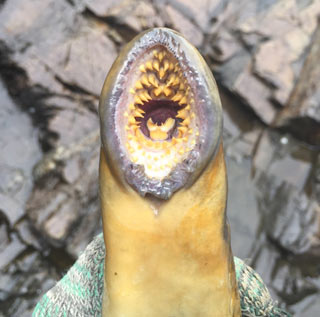Sea Lamprey
Petromyzon marinus
 Distribution: The sea lamprey inhabits Atlantic coastal rivers throughout eastern North America and western Europe, as far south as the western Mediterranean Sea and the gulf coast of Florida. In New Hampshire, sea lamprey migrate into the Connecticut River, Merrimack River, and coastal rivers up to the first impassable barriers.
Distribution: The sea lamprey inhabits Atlantic coastal rivers throughout eastern North America and western Europe, as far south as the western Mediterranean Sea and the gulf coast of Florida. In New Hampshire, sea lamprey migrate into the Connecticut River, Merrimack River, and coastal rivers up to the first impassable barriers.
Description: An eel like fish with a disk-shaped mouth filled with concentric rings of teeth. Sea lamprey may be separated from brook lamprey by their teeth, which, in the brook lamprey, are small and arranged in clusters rather than rings. Adults reach a length of up to three feet and take on a mottled yellow and dark brown coloration during spawning. Larvae do not have teeth or fully developed eyes, but they have the same seven circular gill openings as the adults. The larvae, called ammocoetes, of sea lamprey and American brook lamprey may be distinguished by an unpigmented spot behind the nostril, which is twice the size of the nostril in the brook lamprey and smaller than the nostril in the sea lamprey. Lampreys that have recently reached maturity look like miniature 6- to 8-inch versions of the spawning adults except for their color, which is silvery gray.
Species commonly confused with: American brook lamprey, American eel
Habitat: The habitat preferences of sea lampreys in the ocean are not well understood. In fresh water, sea lampreys use river reaches with gravel substrate for spawning. Spawning habitat is similar to that used by salmon, occurring at the upstream end of riffles and the tail end of pools. Ammocoetes require fine silt and sand that is loose enough to burrow into, yet protected from washing away in higher flows. These areas often occur in the inside of river bends, along stream banks, and behind structures such as boulders or fallen trees.
Life History: Sea lampreys spend their adult lives in the ocean as parasites on fish, which they latch onto with their disk-shaped mouths. After feeding on the blood of multiple fish hosts, sea lampreys leave the ocean and migrate into coastal rivers, where they swim upstream in search of spawning areas. Sea lampreys build nests, or redds, in gravel substrate by rearranging rocks with their mouths. Spawning takes place over a shallow depression in the gravel, where the female will lay an average of 172,000 eggs. After hatching, larvae drift downstream to areas of fine silt and sand, which they burrow into. Known as ammocoetes, larval sea lampreys live as filter feeders in the sediment for up to five years. During their transformation into the adult phase, ammocoetes develop teeth, eyes, and change to a silvery gray color. These newly transformed sea lampreys make their way downstream to the ocean in search of a fish host. Migrating sea lampreys are able detect pheromones from ammocoetes, which they use to navigate to their spawning grounds.
Origin: Native
 Conservation/Management: Dams currently prevent sea lamprey from reaching a majority of their preferred spawning habitat. Fish passage facilities currently provide access to the lower mainstems of the Merrimack, Connecticut, and coastal rivers. Improving fish passage, through fishway construction/modification or dam removal, will benefit sea lamprey populations. Sea lampreys have been credited with improving habitat for other redd building fish species, such as trout and salmon, by loosening the gravel substrate during nest construction. Stocking of sea lampreys upstream is another potential restoration strategy for seeding new populations, since adult lamprey are attracted to chemicals released by ammocoetes. However, research on the Pacific lamprey suggests that populations may be limited more by the availability of fish host species than by access to spawning habitat. If this is the case, then sea lamprey would benefit more from restoring ocean fish stocks than from improved fish passage.
Conservation/Management: Dams currently prevent sea lamprey from reaching a majority of their preferred spawning habitat. Fish passage facilities currently provide access to the lower mainstems of the Merrimack, Connecticut, and coastal rivers. Improving fish passage, through fishway construction/modification or dam removal, will benefit sea lamprey populations. Sea lampreys have been credited with improving habitat for other redd building fish species, such as trout and salmon, by loosening the gravel substrate during nest construction. Stocking of sea lampreys upstream is another potential restoration strategy for seeding new populations, since adult lamprey are attracted to chemicals released by ammocoetes. However, research on the Pacific lamprey suggests that populations may be limited more by the availability of fish host species than by access to spawning habitat. If this is the case, then sea lamprey would benefit more from restoring ocean fish stocks than from improved fish passage.



